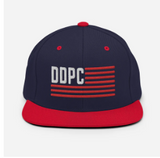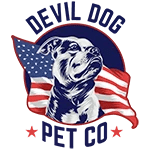The No-BS Guide to Senior Dog Food: What Your Aging Battle Buddy Really Needs
When our dog Dexter hit his golden years, I watched his muzzle turn silver and his sprint turn to a dignified trot. As a Marine, I'd been trained to adapt to changing conditions—and that's exactly what your aging dog's nutrition demands. The kibble that fueled their younger years often falls short when joint stiffness, digestive changes, and metabolic shifts become the new normal.
Senior dog food isn't just marketing hype—it's specialized nutrition that addresses real physiological changes. But here's the hard truth: not all "senior" formulas deserve your trust or your dog's digestive system. Some brands slap a "senior" label on mediocre food and jack up the price, while others genuinely reformulate to support aging bodies.
When "Senior" Actually Matters: Age Is More Than a Number
First things first: when should you make the switch to senior dog food? The answer isn't as simple as "7 years old" or some arbitrary birthday. Small breed dogs might not need senior formulations until 10-12 years, while large breed senior dog food might be appropriate by age 6-7. The timeline depends on your dog's breed, size, activity level, and individual health markers.
Watch for these signals that it's time to transition:
- Decreased energy and activity levels
- Weight gain despite unchanged portions
- Stiffness after rest or exercise
- Digestive changes (gas, inconsistent stool)
- Dental issues affecting kibble consumption
These aren't just "getting old" issues to ignore—they're your dog's body telling you their nutritional needs are changing. When our customers' dogs show these signs, we don't just suggest any senior dry dog food; we recommend formulas specifically matched to their size and health concerns.
The Science Behind Senior Dog Nutrition: What Actually Changes

Your senior dog's body is going through significant changes that directly impact their nutritional requirements. Understanding these shifts is crucial for choosing the right senior dog food—whether you're looking at senior small dog food or large breed senior dog food options.
Metabolism: The Downshift That Demands Attention
Senior dogs experience a 20-25% metabolic slowdown compared to their prime adult years. This means the same portion that maintained perfect weight at age 5 can pack on unhealthy pounds at age 10. Quality senior dog food adjusts caloric density while maintaining essential nutrients—a balancing act that cheap brands often botch.
For small breeds especially, this metabolic change can be dramatic relative to their size. Senior dog food small breed formulations typically feature smaller kibble with precisely calculated calorie-to-nutrient ratios. This prevents weight gain while ensuring these little warriors still get everything they need.
Protein Requirements: More Critical, Not Less
One of the biggest myths in senior dog nutrition is that older dogs need less protein. This outdated belief has led to some senior formulas skimping on this crucial macronutrient. The truth? Senior dogs actually need higher-quality, more digestible protein to maintain muscle mass as they age.
Look for senior dog food with 25–28% protein from named animal sources (chicken, beef dog food, salmon—not just "meat meal"). High protein senior dog food helps preserve lean muscle that supports joint function and maintains metabolism. Without adequate protein, seniors lose muscle mass, which accelerates joint problems and decreases quality of life.
Critical Nutrients Your Senior Dog Can't Live Without
Beyond the basics, certain nutrients become non-negotiable in senior dog food. These aren't fancy add-ons—they're mission-critical components for aging bodies:
Joint Support: The Mobility Maintenance Package
Glucosamine and chondroitin should be standard in any senior dog food, especially large breed senior dog food. These compounds support cartilage health and joint fluid production. The best formulas provide 750-1000mg glucosamine per kg of food—enough to make a measurable difference.
Our customers with large breed seniors consistently report improved mobility within 4-6 weeks when switching to formulas with therapeutic levels of these joint nutrients. For heavy dogs, large breed senior dog food with enhanced joint support isn't a luxury—it's essential preventive maintenance.
Omega Fatty Acids: The Anti-Inflammatory Arsenal
Inflammation is the enemy of aging bodies. Quality senior dog food delivers a balanced ratio of omega-3 to omega-6 fatty acids (ideally 1:5 or better). These compounds fight systemic inflammation that contributes to joint pain, skin issues, and even cognitive decline.
Marine-sourced omega-3s (EPA and DHA) are particularly valuable for senior dogs. These specific fatty acids have been shown to improve mobility and cognitive function in aging canines. Senior diet dog food worth its salt will include these, often from salmon oil or algae sources.
Digestive Support: The Gut Health Battalion
Senior dogs often struggle with digestive efficiency. Fiber becomes increasingly important, but the type matters tremendously. Look for senior dog food with both soluble and insoluble fiber sources—beet pulp, chicory root, and psyllium provide different benefits for gut health and stool quality.
Probiotics are another key component in modern senior formulations. These beneficial bacteria support nutrient absorption and immune function. The best dry senior dog food includes guaranteed levels of live probiotics (measured in CFUs—colony forming units) that survive processing and storage.
Antioxidants: The Cellular Defense Team
Aging increases oxidative stress at the cellular level. Antioxidants like vitamins E and C, along with compounds from blueberries, spinach, and other fruits and vegetables, help neutralize free radicals that damage cells.
Quality senior dog food brands incorporate these protective nutrients in meaningful amounts—not just as label decoration. The difference shows in coat quality, skin health, and overall vitality as your dog ages.
The Grain-Free Question: What Science Actually Says

The debate around grain-free senior dog food continues to evolve. While many owners seek grain free senior dog food based on human diet trends, the science requires a more nuanced approach. The FDA has identified potential links between some grain-free diets and dilated cardiomyopathy (DCM) in dogs—a serious heart condition.
This doesn't mean all grain-free senior dog food is problematic. The concern centers specifically around formulas that replace grains with high levels of peas, lentils, and potatoes. If you're committed to grain free senior dog food, look for formulas that use alternative carbohydrate sources like sweet potatoes and garbanzo beans in moderate amounts.
Critical Nutrients Your Senior Dog Can't Live Without
When our dog Dexter entered his senior years, his nutritional needs shifted dramatically. As a Marine, I learned that mission success depends on proper supply lines—and your aging dog's body is no different. Senior dog food isn't just a marketing gimmick; it's specialized nutrition engineered for aging canine physiology.
Brain Function Support: Combat Cognitive Decline
Senior dogs experience brain changes similar to elderly humans. Medium-chain triglycerides (MCTs) from coconut oil provide alternative brain fuel that can improve cognitive function in aging dogs. Quality senior dog food formulations now include these compounds alongside antioxidants that protect neural tissue.
Look for senior diet dog food containing DHA (docosahexaenoic acid), an omega-3 fatty acid crucial for brain health. Studies show dogs receiving DHA supplements demonstrate better problem-solving abilities and suffer less cognitive dysfunction. This isn't fancy science—it's practical nutrition that keeps your senior's mind sharp and engaged.
Kidney Support: Protecting Vital Filtration Systems
Kidney function naturally declines with age, making protein quality—not just quantity—critically important. Senior dog food formulations should feature highly digestible protein sources that produce fewer nitrogenous waste products for kidneys to filter.
Phosphorus levels matter tremendously in senior nutrition. Excessive phosphorus stresses aging kidneys, so the best senior dog food brands carefully control this mineral. This is particularly important in large breed senior dog food, as bigger dogs are more prone to kidney issues as they age.
Specialized Formulations: Size-Specific Senior Nutrition

One size doesn't fit all when it comes to senior dog food. Small breeds and large breeds age differently and face distinct health challenges that require targeted nutritional approaches.
Small Breed Senior Nutrition: Precision Feeding
Senior dog food small breed formulations address unique needs of aging small dogs. These formulas typically feature:
- Higher caloric density (small dogs have faster metabolisms even in old age)
- Smaller kibble size for dental sensitivity
- Enhanced levels of L-carnitine for fat metabolism
- Targeted dental support ingredients
Dog food for senior small dogs should deliver concentrated nutrition in smaller portions. Small seniors remain metabolically active but eat less volume, making nutrient density crucial. When customers ask about senior small dog food, we emphasize formulas that pack maximum nutrition into minimal kibble size.
Large Breed Senior Needs: Joint-Focused Formulations
Large breed senior dog food prioritizes joint support and weight management—the two most critical factors for aging big dogs. These formulations typically contain:
- Therapeutic levels of glucosamine and chondroitin
- Controlled calorie content to prevent weight gain
- L-carnitine for metabolic support and muscle maintenance
- Balanced calcium-to-phosphorus ratios for bone health
The best large breed senior dog food doesn't just add token amounts of joint supplements—it provides clinically relevant doses. When evaluating options, look for guaranteed minimum levels of these compounds, not just their presence on the ingredient list.
Transitioning to Senior Food: Tactical Approach
Switching to senior dog food requires planning and patience. Abrupt changes can trigger digestive upset, resistance to the new food, or even nutritional gaps during transition. Follow these field-tested protocols for success:
The 10-Day Transition Protocol
Mix the current food with the new senior dry dog food in gradually changing ratios:
- Days 1-2: 75% current food, 25% senior food
- Days 3-4: 50% current food, 50% senior food
- Days 5-7: 25% current food, 75% senior food
- Days 8-10: 100% senior food
Monitor stool quality throughout this process. Soft stool indicates you're moving too quickly—extend each phase by a day or two if needed. This methodical approach minimizes digestive disruption while introducing the benefits of senior nutrition.
Hydration Enhancement Strategies
Senior dogs often experience decreased thirst sensation despite needing more hydration. Enhance dry senior dog food with moisture using these tactics:
- Add warm water to kibble and let it sit for 5 minutes before serving
- Mix in low-sodium broth for flavor and hydration
- Consider feeding systems that combine dry senior dog food with wet food toppers
Proper hydration supports kidney function, digestion, and joint health—all critical systems in aging dogs. This simple step dramatically improves how senior dogs process and utilize their nutrition.
Reading Labels: Decode Senior Dog Food Marketing

Marketing claims on senior dog food packaging often obscure the truth about what's inside. Learn to cut through the noise and identify truly beneficial formulations:
Ingredient Quality Indicators
Superior senior dog food brands specify protein sources clearly—"chicken" or "beef" rather than generic "meat meal." Look for named animal proteins in the first three ingredients, followed by whole food carbohydrate sources like brown rice or sweet potatoes.
Avoid senior formulas with artificial preservatives (BHA, BHT, ethoxyquin), excessive food dyes, or generic "animal by-product meal." These shortcuts signal a manufacturer more concerned with shelf life and appearance than your dog's health. For more on the importance of ingredient quality, check out A Guide to Optimal Canine Nutrition.
Guaranteed Analysis: The Truth Behind the Marketing
The guaranteed analysis section reveals actual nutritional content. For senior dogs, optimal ranges generally include:
- Protein: 25-30% (higher for active seniors, slightly lower for those with kidney issues)
- Fat: 10-14% (adjusted based on activity level and weight management needs)
- Fiber: 3-5% (higher for dogs with digestive or weight management needs)
- Moisture: 10-12% for dry senior dog food
Compare these numbers across brands like Rachael Ray senior dog food versus other options to identify truly superior formulations. Remember that percentages alone don't tell the whole story—ingredient quality determines how well your dog can actually use these nutrients. If you're managing multiple dogs with different needs, see our Essential Tips for Managing Multiple Dogs at Home for practical feeding strategies.
Deciphering "Grain-Free" Claims
Grain-free senior dog food isn't automatically better. The best grain free senior dog food options use quality alternative carbohydrates like sweet potatoes rather than loading up on peas and lentils that have been associated with heart problems in some dogs.
For many seniors, moderate amounts of whole grains provide valuable fiber, B vitamins, and easily digestible energy. The decision between grain-inclusive and grain-free senior dog food should be based on your individual dog's needs and health history, not marketing trends. If your dog has unique dietary needs, our Dog Bowls Guide can help you choose the right feeding system for optimal nutrition.
Supplementing Senior Nutrition: Beyond the Bowl
Even the best senior dog food benefits from strategic supplementation. Based on our experience with Dexter and feedback from thousands of customers, these targeted additions make meaningful differences. For a deeper dive into canine supplements, read our Deer Antler vs. Elk Antler for Dogs comparison.
Explore our top recommended senior dog chews to complement your dog's nutrition:
Supplementing Senior Nutrition: Beyond the Bowl (continued)
Digestive enzymes make a tremendous difference for seniors struggling with nutrient absorption. As dogs age, their natural enzyme production decreases—much like humans. A quality digestive enzyme supplement added to senior dry dog food helps extract maximum nutrition from every bite. When our Dexter hit 11, adding enzymes visibly improved his coat quality within three weeks.
Probiotics specifically formulated for senior dogs support not just digestion, but immune function as well. Nearly 70% of immune tissue resides in the gut, making this investment particularly valuable for aging dogs facing natural immune decline. Look for products with multiple strains and guaranteed live cultures.
High-Protein Considerations for Active Seniors
Not all senior dogs need reduced protein. In fact, high protein senior dog food benefits many active older dogs by preserving muscle mass and supporting metabolism. The key is protein quality, not just quantity.
Premium animal proteins with complete amino acid profiles help maintain lean muscle that would otherwise waste away. For seniors still hiking, swimming, or playing regularly, protein levels between 28-32% support this activity without stressing kidneys—provided they stay well-hydrated.
When customers ask about protein levels for their aging but active companions, I recommend looking beyond percentages to the biological value of the protein sources. Eggs, chicken, and fish deliver more usable amino acids than plant proteins or generic "meat meals."
Addressing Common Senior Health Conditions Through Nutrition
Arthritis affects nearly 80% of dogs over age 8. Beyond glucosamine and chondroitin, look for senior dog food containing natural anti-inflammatories like turmeric (curcumin) and green-lipped mussel extract. These compounds target inflammatory pathways differently than medications, creating a complementary approach to joint care.
Heart health becomes increasingly important as dogs age. Taurine and L-carnitine support cardiac muscle function, while appropriate sodium levels reduce strain on the cardiovascular system. Quality senior diet dog food formulations balance these nutrients carefully.
Dental disease accelerates in senior dogs, making kibble texture and size crucial considerations. Some senior dog food brands engineer kibble specifically to reduce tartar through mechanical cleaning action during chewing. This design consideration matters most for small breed seniors who are particularly prone to dental issues. For more on canine dental care and feeding, see our Dog Side Eye article.
Making the Transition: Practical Strategies
Warming Techniques for Enhanced Palatability
Senior dogs often experience diminished sense of smell, reducing their interest in food. Combat this by slightly warming senior dog food to release aromatic compounds. Microwave dry kibble with a tablespoon of water for 10 seconds, or warm wet food to body temperature.
This simple technique mimics the temperature of fresh prey and significantly increases food appeal. We've seen countless "picky eaters" transform into enthusiastic diners with this minor adjustment—no need for unhealthy toppers or flavor enhancers. If your dog is anxious about changes, our Guide to Keeping Your Dog Calm During Festivities offers helpful tips.
Feeding Schedule Adjustments
Most senior dogs benefit from smaller, more frequent meals rather than one or two large feedings. This approach reduces digestive burden, maintains steadier blood sugar levels, and improves nutrient absorption. Consider dividing your dog's daily ration of senior dog food into 3-4 smaller portions.
For seniors with early cognitive changes, maintaining strict feeding schedule consistency provides valuable routine and reduces anxiety. Set alarms if needed—predictability becomes increasingly important as dogs age. If you travel often, see our Comprehensive Guide to Traveling with Dogs for feeding and care tips on the go.
Monitoring Weight and Body Condition
Senior dogs require regular weight checks and body condition assessments. Weigh your dog monthly and adjust portion sizes of their senior dog food accordingly. Maintain a body condition score between 4-5 on the 9-point scale—you should feel ribs easily with light pressure but not see them.
Document these measurements in a simple tracking system. Weight changes exceeding 5% warrant veterinary consultation, as they may indicate underlying health issues or the need for nutritional adjustments. For more on health monitoring, review our Basic First Aid Skills Every Pup Parent Should Know.
Conclusion: Leadership in Senior Nutrition
Providing optimal nutrition for your aging dog isn't just about buying senior dog food—it's about taking extreme ownership of their changing needs. The right nutritional approach combines thoughtful food selection, strategic supplementation, and consistent monitoring to support your loyal companion through their golden years.
Remember that nutrition is your most powerful daily intervention in your senior dog's health and quality of life. The investment you make in premium senior dog food, proper transitions, and individualized adjustments pays tremendous dividends in mobility, cognition, and vitality. Your senior deserves nothing less than this level of commitment—and with the knowledge you've gained, you're now equipped to deliver exactly that.
For more detailed guidance on choosing the right food for your senior dog, visit Cornell's Canine Health Information on Choosing Food for Your Senior Dog.
Download the FREE 10-Step Dog Prep Guide
Frequently Asked Questions
What is the best food for senior dogs?
The best food for senior dogs is one that supports their changing nutritional needs, often featuring higher quality protein, joint-supporting ingredients like glucosamine, and antioxidants for immune health. It should be easily digestible and balanced to maintain a healthy weight, as older dogs tend to be less active. Consulting with your veterinarian can help tailor the diet to your dog's specific health conditions.
Does senior dog food make a difference?
Yes, senior dog food can make a significant difference by addressing the unique needs of aging dogs, such as reduced metabolism, joint health, and cognitive function. These formulas often contain adjusted nutrient levels to prevent obesity and support organ health, which can improve your dog's quality of life and longevity. Feeding age-appropriate food helps manage common senior health issues more effectively.
What to feed my 13 year old dog?
For a 13-year-old dog, it's important to provide a diet that is nutrient-dense yet easy to digest, often found in senior dog foods with moderate protein and fat content. Look for ingredients that support joint health, like omega-3 fatty acids, and antioxidants to boost the immune system. If your dog has specific health concerns, such as kidney issues or dental problems, consult your vet for a specialized diet recommendation.
What's the difference between blue buffalo adult and senior food?
Blue Buffalo adult food is formulated for dogs in their prime, focusing on balanced nutrition to maintain energy and overall health, while the senior formula is tailored to meet the needs of aging dogs. The senior recipe typically includes joint support ingredients like glucosamine and chondroitin and may have adjusted calorie levels to prevent weight gain. Additionally, senior formulas often emphasize ingredients that support cognitive function and digestive health.
What to feed a dog at the end of life?
At the end of life, a dog's diet should prioritize comfort and ease of eating, often shifting to softer, highly palatable foods that are gentle on the stomach. Foods rich in easily digestible proteins and fats can help maintain energy, while hydration is crucial. It's important to work closely with your veterinarian to address any specific health issues and ensure your dog’s nutritional needs are met compassionately.
Should senior dogs eat wet or dry food?
Both wet and dry food have benefits for senior dogs; wet food can be easier to chew and helps with hydration, especially if your dog is less inclined to drink water. Dry food is convenient, supports dental health by reducing tartar buildup, and is often more calorie-dense. Many pet owners find a combination of both works best, but the choice should depend on your dog's preferences, dental condition, and any veterinary recommendations.






